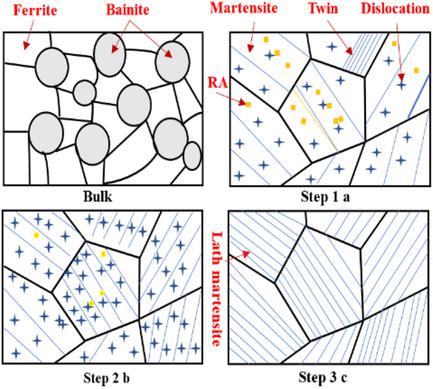当前位置:
X-MOL 学术
›
Steel Res. Int.
›
论文详情
Our official English website, www.x-mol.net, welcomes your
feedback! (Note: you will need to create a separate account there.)
Effect of Microstructure on Hardness and Wear Properties of 45 Steel after Induction Hardening
Steel Research International ( IF 1.9 ) Pub Date : 2021-01-09 , DOI: 10.1002/srin.202000540 Jing Li 1, 2 , Zhongxuan Cao 1, 2 , Lin Liu 1, 2 , Xuedong Liu 1, 2 , Jian Peng 1, 2
Steel Research International ( IF 1.9 ) Pub Date : 2021-01-09 , DOI: 10.1002/srin.202000540 Jing Li 1, 2 , Zhongxuan Cao 1, 2 , Lin Liu 1, 2 , Xuedong Liu 1, 2 , Jian Peng 1, 2
Affiliation

|
Herein, the mechanical properties and microstructural evolution of 45 steel subjected to induction hardening (IH) is studied. To study the strengthening mechanism of IH on the 45 steel, the flow rate (FL) with 50, 60, and 70 L min−1 are chosen to cool the samples. The hardness distribution in the near‐surface layer is measured by a CARAT 930 Vickers hardness tester. The metallographic structures of the 45 steel with and without IH are analyzed by optical microscope (OM) and transmission electron microscopy (TEM). The phase analysis in the surface layer is determined by X‐ray diffraction (XRD). Combined with OM and hardness distribution, the results indicate that bainite is the reason for the low hardness of the raw material. Also the wear mechanism of 45 steel changes from adhesive wear and delamination to abrasive wear. Moreover, when FL increases from 50 to 70 L min−1, the surface hardness of 45 steel raises by 19.86% and the coefficient of friction reduces from 0.122 to 0.0418. Combined with TEM analysis, the determinate factors of surface hardness and tribological characteristics owes to martensite grain refinement, during the process of transforming austenite to martensite. Dislocations provide conditions for martensite nucleation, the driving force of the phase change generated by thermal deformation and FL drop provides energy for martensite nucleation.
中文翻译:

感应淬火后显微组织对45钢硬度和磨损性能的影响
在此,研究了45钢经过感应淬火(IH)的力学性能和组织演变。研究IH在45钢上的强化机理,以及50、60和70 L min -1下的流量(FL)选择冷却样品。近表面层的硬度分布是通过CARAT 930维氏硬度计测量的。用光学显微镜(OM)和透射电子显微镜(TEM)分析了有和没有IH的45钢的金相组织。表面层的相分析是通过X射线衍射(XRD)确定的。结合OM和硬度分布,结果表明贝氏体是原材料硬度低的原因。同样,45钢的磨损机理也从粘合剂磨损和脱层到磨料磨损。此外,当FL从50 L min -1增加到70 L min -1时,45钢的表面硬度提高了19.86%,摩擦系数从0.122降低至0.0418。结合TEM分析,在奥氏体转变为马氏体的过程中,表面硬度和摩擦学特性的决定因素归因于马氏体晶粒细化。位错为马氏体成核提供了条件,由热变形和FL下降产生的相变的驱动力为马氏体成核提供了能量。
更新日期:2021-01-09
中文翻译:

感应淬火后显微组织对45钢硬度和磨损性能的影响
在此,研究了45钢经过感应淬火(IH)的力学性能和组织演变。研究IH在45钢上的强化机理,以及50、60和70 L min -1下的流量(FL)选择冷却样品。近表面层的硬度分布是通过CARAT 930维氏硬度计测量的。用光学显微镜(OM)和透射电子显微镜(TEM)分析了有和没有IH的45钢的金相组织。表面层的相分析是通过X射线衍射(XRD)确定的。结合OM和硬度分布,结果表明贝氏体是原材料硬度低的原因。同样,45钢的磨损机理也从粘合剂磨损和脱层到磨料磨损。此外,当FL从50 L min -1增加到70 L min -1时,45钢的表面硬度提高了19.86%,摩擦系数从0.122降低至0.0418。结合TEM分析,在奥氏体转变为马氏体的过程中,表面硬度和摩擦学特性的决定因素归因于马氏体晶粒细化。位错为马氏体成核提供了条件,由热变形和FL下降产生的相变的驱动力为马氏体成核提供了能量。











































 京公网安备 11010802027423号
京公网安备 11010802027423号